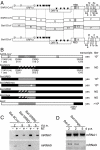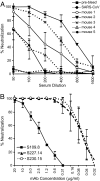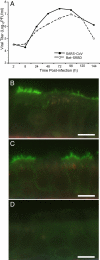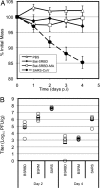Synthetic recombinant bat SARS-like coronavirus is infectious in cultured cells and in mice
- PMID: 19036930
- PMCID: PMC2588415
- DOI: 10.1073/pnas.0808116105
Synthetic recombinant bat SARS-like coronavirus is infectious in cultured cells and in mice
Abstract
Defining prospective pathways by which zoonoses evolve and emerge as human pathogens is critical for anticipating and controlling both natural and deliberate pandemics. However, predicting tenable pathways of animal-to-human movement has been hindered by challenges in identifying reservoir species, cultivating zoonotic organisms in culture, and isolating full-length genomes for cloning and genetic studies. The ability to design and recover pathogens reconstituted from synthesized cDNAs has the potential to overcome these obstacles by allowing studies of replication and pathogenesis without identification of reservoir species or cultivation of primary isolates. Here, we report the design, synthesis, and recovery of the largest synthetic replicating life form, a 29.7-kb bat severe acute respiratory syndrome (SARS)-like coronavirus (Bat-SCoV), a likely progenitor to the SARS-CoV epidemic. To test a possible route of emergence from the noncultivable Bat-SCoV to human SARS-CoV, we designed a consensus Bat-SCoV genome and replaced the Bat-SCoV Spike receptor-binding domain (RBD) with the SARS-CoV RBD (Bat-SRBD). Bat-SRBD was infectious in cell culture and in mice and was efficiently neutralized by antibodies specific for both bat and human CoV Spike proteins. Rational design, synthesis, and recovery of hypothetical recombinant viruses can be used to investigate mechanisms of transspecies movement of zoonoses and has great potential to aid in rapid public health responses to known or predicted emerging microbial threats.
Conflict of interest statement
Conflict of interest statement: R.E.J. is a coinventor of the Venezuelan Equine Encephalitis (VEE) expression vector technology and holds an equity interest in AlphaVax, Inc., the company that has licensed this technology from the University of North Carolina.
Figures





Similar articles
-
Pathways of cross-species transmission of synthetically reconstructed zoonotic severe acute respiratory syndrome coronavirus.J Virol. 2008 Sep;82(17):8721-32. doi: 10.1128/JVI.00818-08. Epub 2008 Jun 25. J Virol. 2008. PMID: 18579604 Free PMC article.
-
Synthetic reconstruction of zoonotic and early human severe acute respiratory syndrome coronavirus isolates that produce fatal disease in aged mice.J Virol. 2007 Jul;81(14):7410-23. doi: 10.1128/JVI.00505-07. Epub 2007 May 16. J Virol. 2007. PMID: 17507479 Free PMC article.
-
Isolation and characterization of a bat SARS-like coronavirus that uses the ACE2 receptor.Nature. 2013 Nov 28;503(7477):535-8. doi: 10.1038/nature12711. Epub 2013 Oct 30. Nature. 2013. PMID: 24172901 Free PMC article.
-
SARS-CoV and emergent coronaviruses: viral determinants of interspecies transmission.Curr Opin Virol. 2011 Dec;1(6):624-34. doi: 10.1016/j.coviro.2011.10.012. Curr Opin Virol. 2011. PMID: 22180768 Free PMC article. Review.
-
Review of bats and SARS.Emerg Infect Dis. 2006 Dec;12(12):1834-40. doi: 10.3201/eid1212.060401. Emerg Infect Dis. 2006. PMID: 17326933 Free PMC article. Review.
Cited by
-
Self-Replicating RNA Derived from the Genomes of Positive-Strand RNA Viruses.Methods Mol Biol. 2024;2786:25-49. doi: 10.1007/978-1-0716-3770-8_2. Methods Mol Biol. 2024. PMID: 38814389
-
Design and Application of Biosafe Coronavirus Engineering Systems without Virulence.Viruses. 2024 Apr 24;16(5):659. doi: 10.3390/v16050659. Viruses. 2024. PMID: 38793541 Free PMC article. Review.
-
ACE2 from Pipistrellus abramus bats is a receptor for HKU5 coronaviruses.bioRxiv [Preprint]. 2024 Aug 16:2024.03.13.584892. doi: 10.1101/2024.03.13.584892. bioRxiv. 2024. PMID: 38559009 Free PMC article. Preprint.
-
Genetic loci regulate Sarbecovirus pathogenesis: A comparison across mice and humans.Virus Res. 2024 Jun;344:199357. doi: 10.1016/j.virusres.2024.199357. Epub 2024 Mar 23. Virus Res. 2024. PMID: 38508400 Free PMC article.
-
Isolation of ACE2-dependent and -independent sarbecoviruses from Chinese horseshoe bats.J Virol. 2023 Sep 28;97(9):e0039523. doi: 10.1128/jvi.00395-23. Epub 2023 Sep 1. J Virol. 2023. PMID: 37655938 Free PMC article.
References
Publication types
MeSH terms
Substances
Associated data
- Actions
- Actions
Grants and funding
LinkOut - more resources
Full Text Sources
Other Literature Sources
Miscellaneous

